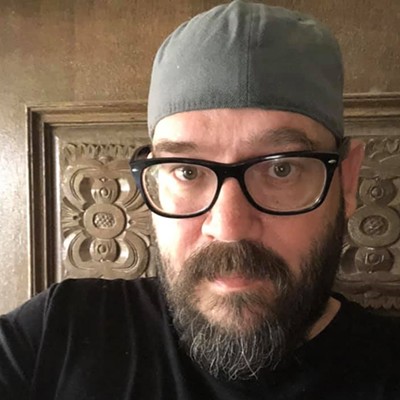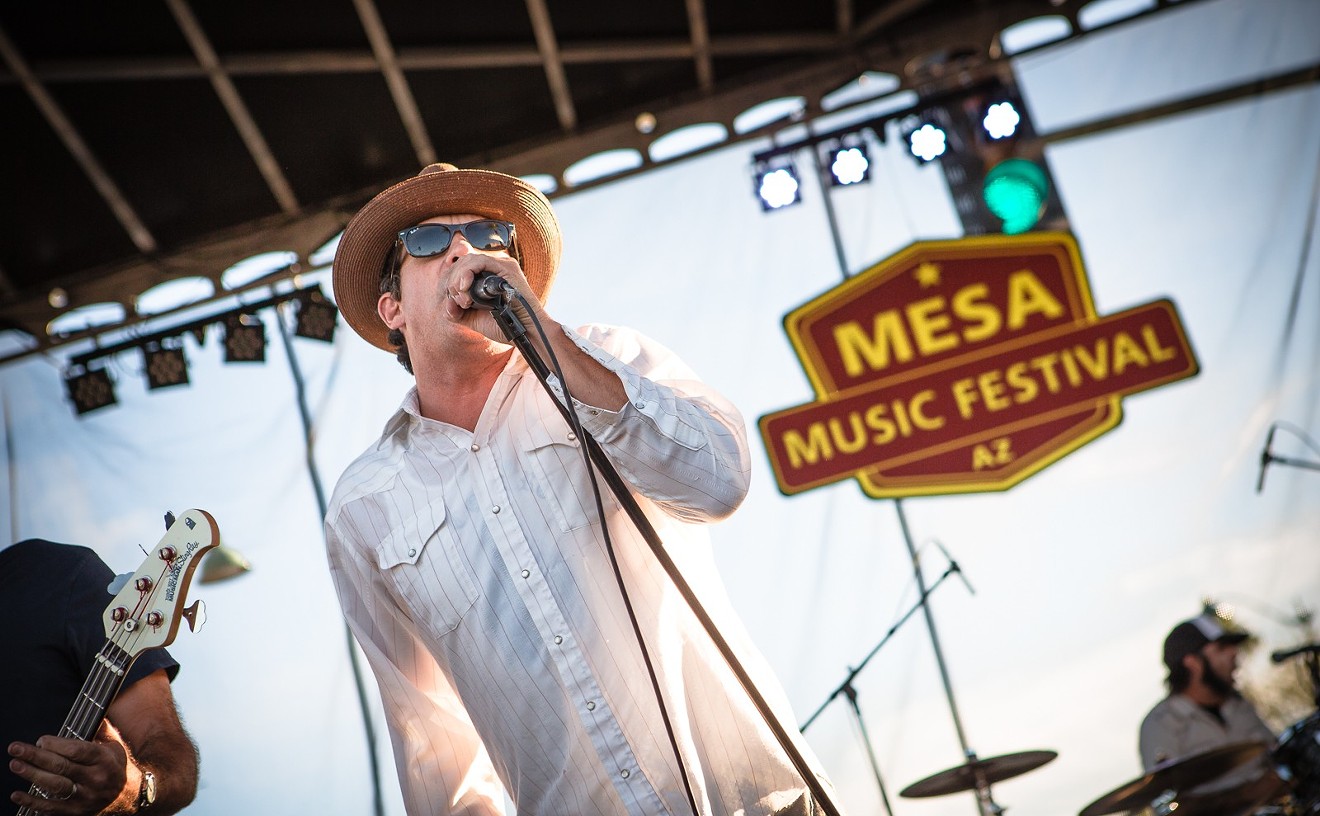Quite frankly, it looks like a thrift store exploded inside the cluttered confines of the 27-year-old's central Phoenix residence, as almost every inch of floor space is choked with a collection of castoff items, including colorful kids' toys, vintage home electronics, bygone arcade games, stacks of ancient videotapes, and crates of LPs.
Currently, Busboom isn't concerned with any of the Atari 2600 game systems or decaying Betamax VCRs dotting his dwelling, but is focused on dismantling a silver-and-blue toy ray gun. The gaunt musician pops fresh double-A batteries into the wanna-be weapon, and uses a screwdriver to quickly dismantle it with the dexterity of a jarhead grunt field-stripping an M-16.
Sitting in his dank basement workspace, Busboom sorts through a jumble of wires and LEDs from the dismantled pistol, seeking the true target of his destructive deed: an inch-long circuit board at the heart of the hand cannon.
"Look how simple this circuit is," Busboom says. "This is gonna be easy."
He swiftly solders some short lengths of insulated wire to different points on the metallic green wafer, transforming the normally shrill tones of simulated electric death produced by the pistol into a noisy, static-filled staccato.
"Shit, I'm not getting the laser noise that I wanted," Busboom says. "This is really a trial-and-error process to find the cool-ass sounds. This is a cheap toy, but I gotta be careful 'cause I could end up frying the board."
Welcome to the weird and wired world of circuit bending, where musically inclined mad scientists like Busboom perform auditory autopsies on secondhand sound-generating machines like children's toys and keyboards to transmogrify their output and create experimental instruments.
These gonzo gadgets generate plenty of squawks, warblings, glitches, and bleeps for myriad noise artists, experimental musicians, and electronica enthusiasts from around the world to incorporate into their gigs. For instance, Busboom mixes altered drum machines, keyboards, and childhood playthings onto a synth backbeat from a Commodore 64 for his outfit The Coitus.
Although circuit bending is entirely a fringe art form, the curious craft has slowly been sparking toward the mainstream musical world. Some big-time musicians, including Tom Waits and Nine Inch Nails' Trent Reznor, have taken an interest, and the hobby has garnered attention in the national press, including an article in Wired magazine. Meanwhile, here in the Valley, a number of local musicians and groups in addition to Busboom utilize "bent" instruments to varying degrees in their acts, including the distortion-heavy industrial sound of Clew of Theseus, the nü-jazz/electronica group Morgan's Magic Book Bus, and one-man synth terrorist Treasure Mammal.
Busboom's experimentations with audio equipment began in 2004, when onetime roommates Jeremy and Anna Kinison of Cut Throat Freak Show fame introduced him to the art. Busboom started out like many newbie benders, cracking open low-voltage, secondhand audio playthings — such as a Speak & Spell, which is renowned among benders because of the ease with which it can be altered and its large vocabulary of words and sounds. Bits of wire or alligator clips are used to probe different circuits, resistors and capacitors while the devices are in operation in order to monitor the audio output.
The more interesting results during this circuit surgery are hardwired by soldering or adding in audio outputs, resistors and oscillators, as well as buttons and switches to regulate things. If the original case won't handle all these new additions, Busboom will create custom-built containers. Benders can also modify sounds through contact with their own skin, either by pressing their flesh to exposed circuits or wiring contacts to the outside of the instrument.
But circuit bending ain't just some vast toy story, as plenty of other sound generators can be messed with. Keyboards such as the Casio SK-1 are popular among benders, and Busboom says occasionally you'll see Korgs and Moogs experimented with (although it's somewhat rare, given the value of these instruments).
Jesse Rutherford, a 30-year-old audio tech for KNXV-TV Channel 15, has been performing circuit surgery since 2002 and focuses on modifying guitar pedals and drum machines, and is currently futzing with a door alarm meant for teenagers. He says anything that makes noise is fair game, as long as you have the patience to fool around. "Bending is all about how much time you're willing to spend poking and prodding around, looking for the sweet spots," says Rutherford, who's a regular at the Cone Gallery's monthly Third Friday experimental noise jams. "You can usually get some quick and dirty stuff by staying simple, but there are infinite possibilities to be had, depending on how far you're willing to go."
Busboom says there's always a constant risk of permanently annihilating whatever gear he's modifying, so he uses some somewhat "disposable" devices. "Half the time you circuit bend something, you might end up ruining the toy or keyboard you're working on," he says. "So unless you're willing to lose something, don't fuck with it."
But even though he's trashed plenty of burnt-out components, Busboom describes circuit bending as "sort of the finger-painting of electronic music," which thrives on spontaneity, as well as trial and error. "It's a very simple and open art form, built on a lot of tinkering, being creative, fooling around, and making old junk useful again," he says.
Although messing around MacGyver-style with musical machines stretches back to the 1950s (when synthesizer designer Serge Tcherepnin fooled with shorting out and adding body contacts to electronic devices and transistor radios), the widely recognized pioneer in the field is Reed Ghazala, an Ohio tech-head who started his audio experimental efforts in the mid-1960s and coined the term "circuit bending."
Ghazala says he accidentally stumbled on the art when a small battery-powered amplifier in a desk drawer short-circuited after contacting something metallic and "started making these strange noises." After experimenting with bending toys and building homebrew-style synthesizers for decades, Ghazala began writing about his experiences in 1992 for Experimental Musical Instruments magazine and was one of the first to offer instructional information on the Internet in the late '90s. He's constructed hundreds of artfully made devices, such as surreally redecorated Speak & Spells called "Incantors," and alien-like "Photon Clarinets." He says he's given some of his works to members of the Rolling Stones, Blur, and even Trent Reznor (who invited him backstage to a Nine Inch Nails concert in Cincinnati last year).
Ghazala's loath to mention these marquee fans, as he claims the real attention on circuit bending should be on its simplicity and do-it-yourself sensibilities. "Circuit bending is so simple to learn and has stripped the necessity of lengthy study [for] becoming an electrical engineer — which is the usual course you take before you can design an original instrument. Its techniques allow anybody to create an experimental musical instrument almost instantaneously," Ghazala says. "Anybody with a curious nature and a few dollars to spend on a soldering iron and secondhand devices could follow the same exploration route that I followed."
Practicing what he preaches, Ghazala's Web site (www.anti-theory.com) contains voluminous how-to info on circuit bending. He's also thrilled at the number of circuit-bending expos that have sprung up around the country in recent years, pointing to its growing popularity. Cities such as Los Angeles and New York have hosted events in recent years, and even this year's annual TapeOpCon in Tucson had a bending seminar. Phoenix is also getting a taste of the action, as the Trunk Space is presenting an event this week that's a combination circuit-bending workshop, swap meet, and concert.
Busboom will be at the event sharing his knowledge, and hopes to inspire others to follow his path. "The great thing about circuit bending is that you don't need a home studio or an electronics degree to create music. You just need some basic tools, a trip to the thrift store, and a Saturday afternoon," Busboom says. "And you can create sounds that would require $2,000 synthesizers to create for only like, three bucks."











